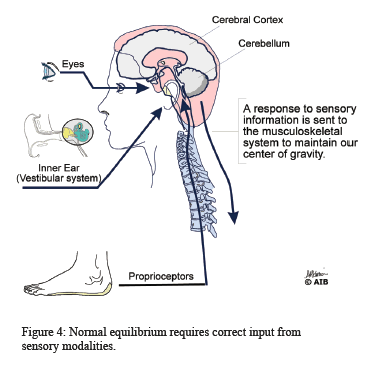Vestibular Rehabilitation
Producing Successful Outcomes
Vestibular Rehabilitation Therapy (VRT) can best be described as systematic repetitive exercises and protocols which extinguish or ameliorate patients motion provoked symptoms as well as enhancing postural stability and equilibrium. VRT is not new; it dates back to the 1940s. Cawthorne and Cookseys articles began to discuss the benefit of active eye and head movement exercise for patients who experienced labyrinthine problems. This was followed in 1980 by the work of Brandt and Daroff, which became known as the Brandt exercises. Since then, research and clinical experience has greatly advanced the scientific application of this treatment methodology.
During the past several years, VRT has been gaining acceptance by physicians, therapists, and audiologists. Both the American Speech-Language-Hearing Assn. (ASHA) 4 and the American Academy of Audiology (AAA) have recognized the role of VRT within the audiologists scope of practice. The American Academy of Otolaryngology-Head and Neck Surgery (AAO-HNS) 6 has also supported the role of VRT in the management of vestibular patients. Additionally, physical and occupational therapists and their respective organizations have supported this subspecialty within their professions.
How does VRT work?
The underlying physiological basis for VRT is the plasticity of the central nervous system. VRT does not actually involve a regeneration or treatment of the damaged vestibular end organ itself. Instead, it works by allowing the central nervous system and the brain to acclimate or adapt to asymmetrical/conflicting input coming from the vestibular mechanisms. Theoretically, central compensation should occur within 90 days following dysfunction or loss of one of the vestibular systems. However, many vestibular lesions, particularly those that occur with rapid onset, do not benefit from this compensation phenomenon.
Complicating or retarding the phenomenon of central compensation is the reluctance of the patient to do any of those activities involving active head motion which produce symptoms of dizziness. This often is one of the main reasons why central compensation does not occur in so many individuals. To quote David Zee, M.D. of Johns Hopkins, The brain cannot fix what the brain cannot see. Other complicating factors include drugs like Meclizine, Antivert, Valium or other pharmaceuticals which suppress either peripheral vestibular or CNS function. These drugs will also delay or prevent the central nervous system from relearning or adapting to asymmetrical sensory input. Unfortunately, the dizzy patient, in his/her heightened anxiety about becoming dizzy (especially while at work or driving) becomes reliant on those pharmaceuticals that assist in suppressing their symptoms. These pharmaceuticals are often dispensed to patients who would be far better off without them.
Benefits of VRT
- May be the best or only management.
- Cost effective.
- Non-invasive.
- Short course of therapy.
- User friendly.
- Returns or restores everyday function.
Who is VRT for?
Vestibular rehabilitation therapy works best when it is utilized with individuals who are outside of the acute phase of a condition (e.g. symptoms no longer include the acute labyrinthine storm with debilitating vertigo accompanied by nausea, vomiting and diaphoresis). The patient who is in the midst of a labyrinthine storm secondary to labyrinthitis, vestibular neuritis or active Menieres disease will receive little or no benefit from VRT. However, most patients will be in a stabilized condition. This may include any condition which causes a vestibulopathy (weakness or loss of vestibular function), such as a Menieres patient who is in the end-stage where there are no longer attacks, and the individuals fluctuating hearing loss is stabilized. This also applies to labyrinthitis, vestibular neuronitis, vertebrobasilar and labyrinthine ischemias.
These patients typically present symptoms that are provoked with active head movement often at a particular frequency of motion and in a particular direction. There may also be significant visual provocation as well. The patient may present complaints related to an inability to drive down a particular street if they are looking out the side window where there are numerous telephone poles. It is common for patients to express a sense of motion sickness while they are looking at certain patterns of floor tile or wallpaper. One of the most common patient complaints is difficulty walking down the aisle of a grocery store while turning their head from side to side and up and down while shopping.
REFERENCES
- Cawthorne, T: The Physiological Basics for Head Exercises. S Chartered Soc Physiother. 30:106, 1944.
- Cooksey, F.S.: Rehabilitation in Vestibular Injuries. Pro R Soc Med. 39:273, 1946.
- Brandt, T and Daroff, RB: Physical Therapy for Benign Paroxysmal Positional Vertigo. Arch Otolaryngology. 106:484, 1980.
- American Speech, Hearing, Language Association Supplement. Spring 1996. ASHA Volume 39 Number 2.
- American Academy of Audiology. Vestibular Issues. Task Force 1999.
- American Academy of Otolaryngology. Head and Neck Surgery Bulletin. Policy statements October 1998. Vol 17, No. 10.
- Gans, RE: Dizziness, Loss of Balance and Movement Therapy. Penn State Sports Medicine Newsletter. June 1997. Vol. 5, No. 10.
- Gans, RE: Vestibular Rehabilitation: Protocols and Programs. Singular Publishing Group 1996.
- Girardi, M and Konrad, HR: Vestibular Rehabilitation Therapy for the Patient with Dizziness and Balance Disorders. Head and Neck Nursing. Fall 1998. Vol. 16, No. V.